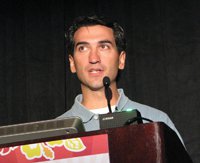Nonoperative tennis elbow treatment still standard as interest in endoscopy expands
Arthroscopy helps diagnose, treat plicas and synovitis, but requires care to avoid nerve injuries.

When the extensor carpi-radialis brevis tissue develops pathological problems, like tendinosis, exostosis and calcification, known as lateral epicondylitis, surgery is sometimes the only avenue to pain relief. But upper extremity specialists are now debating whether operating open or arthroscopically is best.
Robert P. Nirschl, MD, who has championed open surgery for lateral epicondylitis, reported extremely good results performing extensor carpi-radialis brevis (ECRB) releases that way.
In support of the endoscopic technique, Christopher S. Ahmad, MD, discussed its advantages in a presentation at Orthopedics Today Hawaii 2008.
|
Image: Beadling L, Orthopedics Today |
“Patients’ recovery is enhanced. Their outcome is equivalent and there’s no increased rate of complications,” he said.
Endoscopic ECRB releases may also mitigate complications like nerve lacerations and injuries to the lateral ulnar collateral ligament (LUCL).
Bracing, steroids
Ahmad reviewed the effectiveness of proven nonoperative treatments for lateral epicondylitis, including activity modification, bracing and steroid injections.
“Treatment for these patients is nonoperative and I’d like to emphasize that. So we are not operating on these patients, in general. They usually respond to nonoperative treatment,” he said.
Low-cost counterforce braces have produced good results and are well tolerated. They transfer force from the ECRB and its origin and distributes it more evenly, allowing the tendon to heal.
Using steroids and other injections may enhance early recovery but could cause calcium deposits, Ahmad said. Research shows with longer follow-up, results for patients treated with injections may be similar to patients who did not receive them.
Surgical indications
Special imaging is not typically needed for lateral epicondylitis or “tennis elbow.” MRI is rarely indicated, especially if the classic signs are present: handshake weakness and tenderness over the ECRB insertion.
Surgery is indicated for patients who failed a comprehensive course of nonoperative treatment and have continued pain that interferes with daily activities.
Before surgery Ahmad suggested assessing compliance and motivation, which explain why a patient failed to respond to nonoperative treatment.
With either type of surgery, “We want to minimize any morbidity and complications with our surgical technique,” he said.
|
Images: Ahmad CS |
Arthroscopy pointers
According to Ahmad, arthroscopy allows addressing articular pathology and is useful for diagnosing and treating radiocapitellar plicas and synovitis. It also meets the surgical goals of tissue resection if the ECRB release is done adequately and complications are avoided.
When surgery is required, surgeons should avoid common but critical nerve and ligament injuries. Before starting the arthroscopic procedure, he suggested they immediately identify the ulnar nerve by outlining the area around it and the bony landmarks and keep the nerve’s location in mind throughout surgery.
Frequently, the ulnar nerve subluxes, which is a contraindication for a standard medial portal. To avoid nerve injury in those cases dissect down, controlling the nerve and ensuring it is protected, Ahmad said.
To avoid injuring the LUCL, located just below the equator of the radial head, “make sure you don’t go below the equator” or release any tissues there, he noted, saying research by Cummins found a learning curve with arthroscopic releases.
Rehab is essential
Ahmad prefers the lateral position with medial and anterolateral portals. He recommended using blunt instruments for dissection via a nick-and-spread approach that avoids cutaneous nerve injuries. The ECRB is found between the common extensor and the capsule dissect just lateral to the articular surface. The goal is to debride the tendon and release it.
Rehabilitation is essential to good outcomes.
“Because it’s a limited procedure, you can be a little bit more aggressive,” Ahmad said. Active/passive range of motion can be done immediately postop to obtain full elbow extension. Formal physical therapy, including stretching and strengthening, should start a week later after the stitches are removed. Once patients regain strength they can return to full activity. Most return to work fairly quickly.
|
|
For more information:
- Christopher S. Ahmad, MD, assistant professor of orthopedic surgery, Columbia University, Center for Shoulder, Elbow and Sports Medicine can be reached at 622 W. 168th St., New York, NY 10032; 212-305-5561; e-mail: csa4@columbia.edu. He has received grant research support from Arthrex Inc.
Reference:
- Ahmad CS. Lateral epicondylitis — Current management strategies. Presented at Orthopedics Today Hawaii 2008. Jan. 13-16, 2008. Lahaina, Maui, Hawaii.





